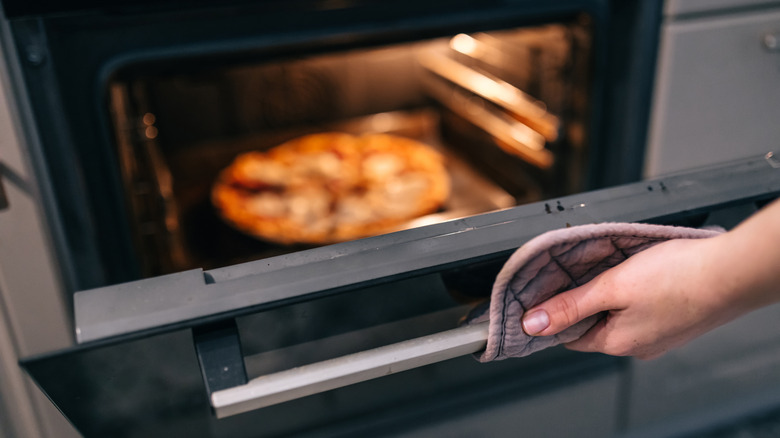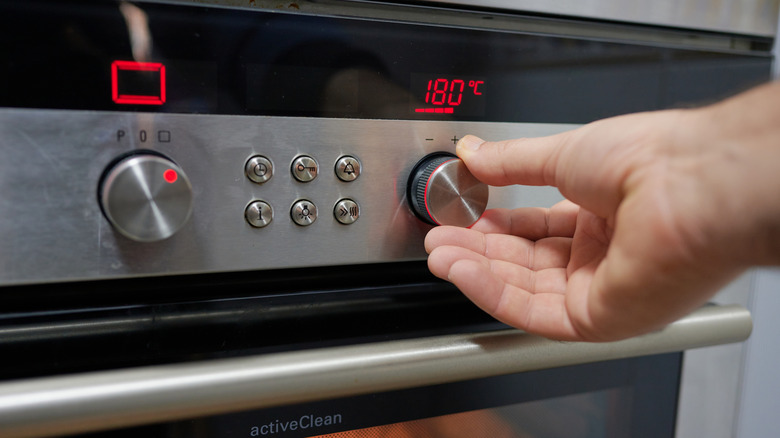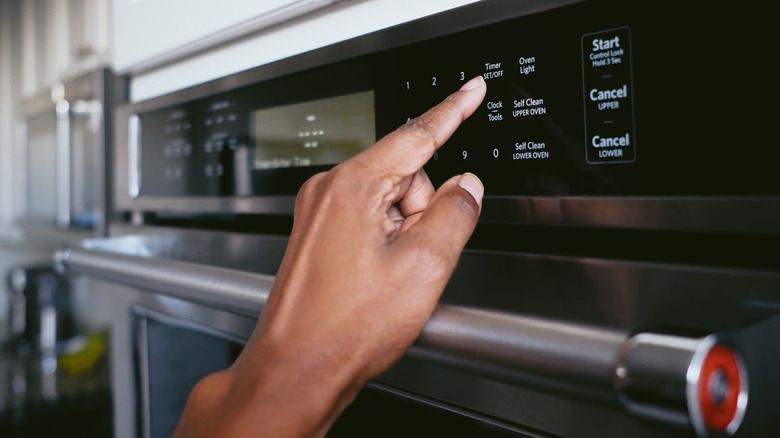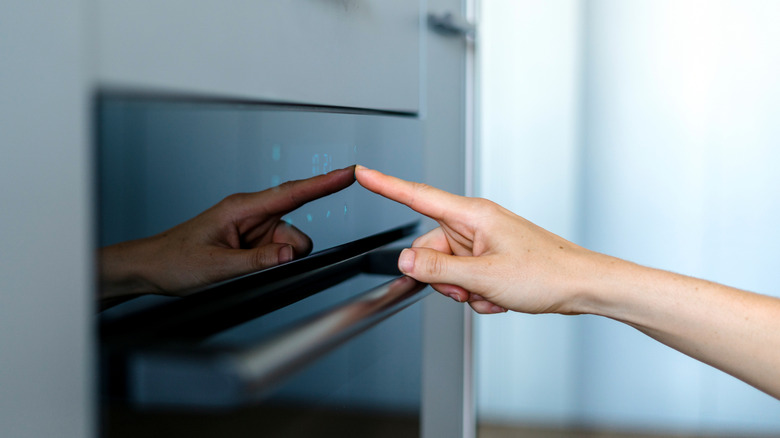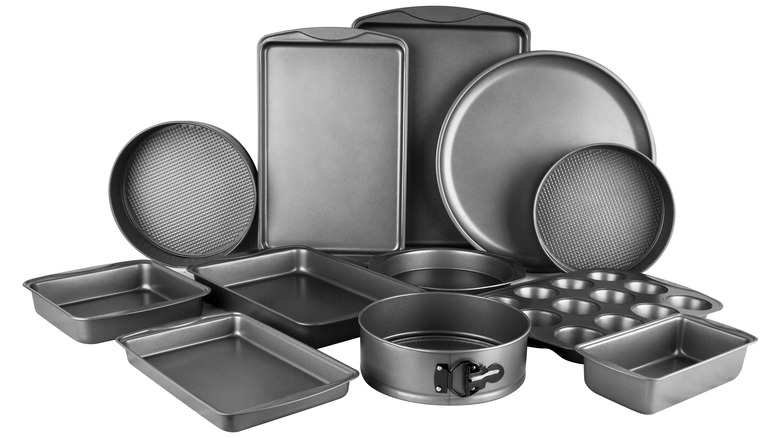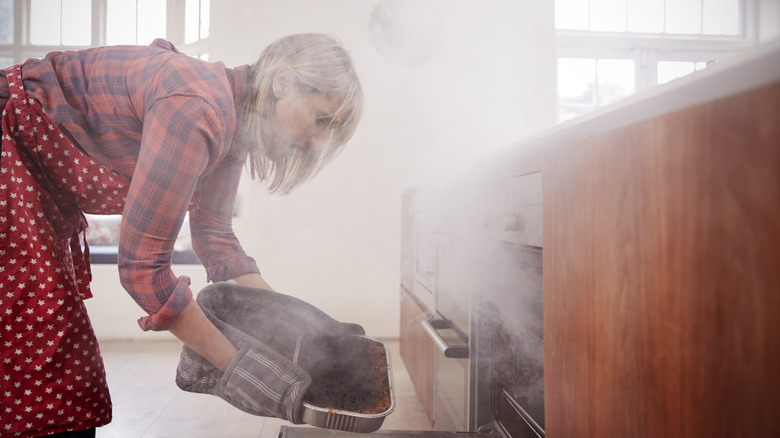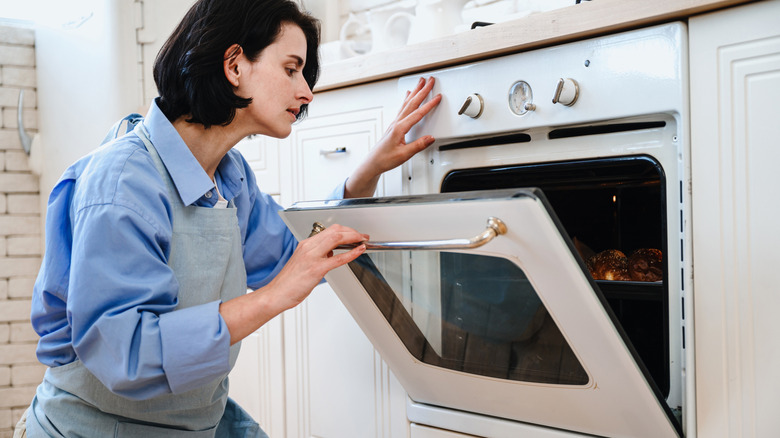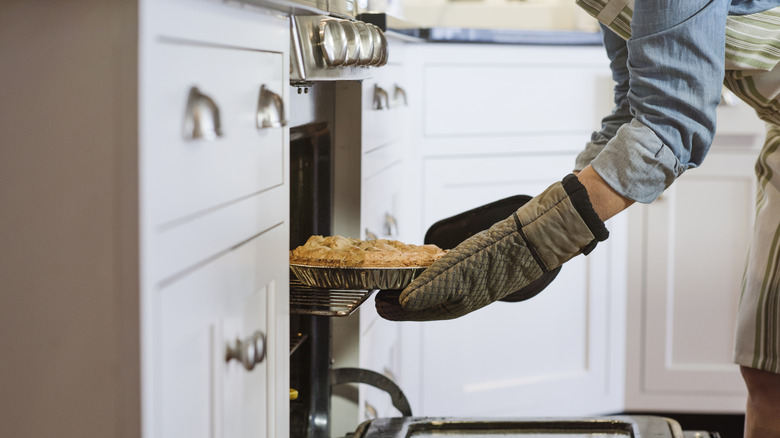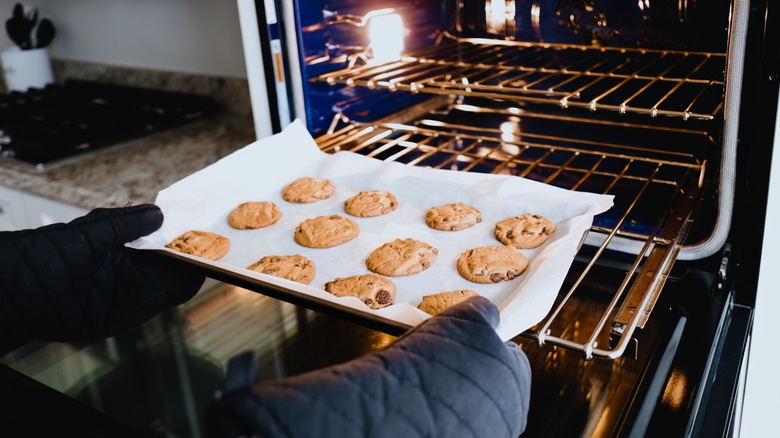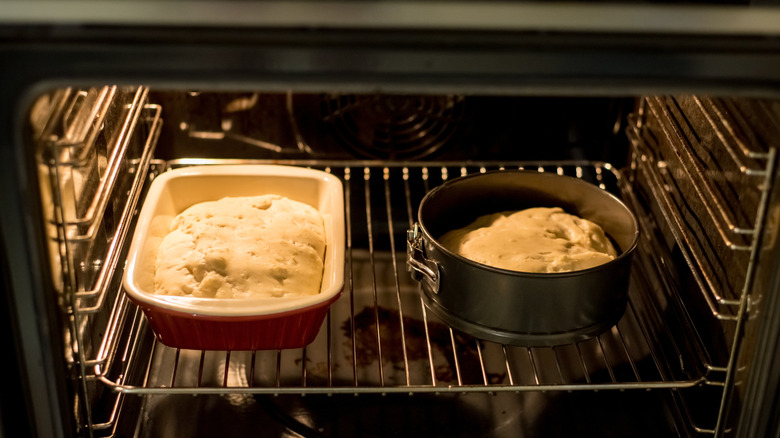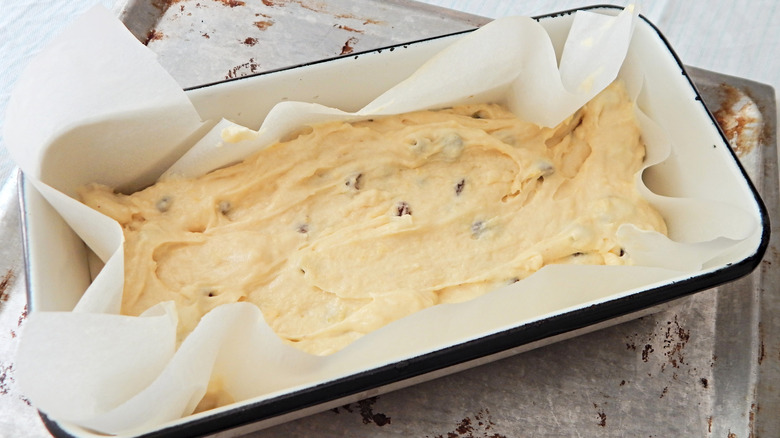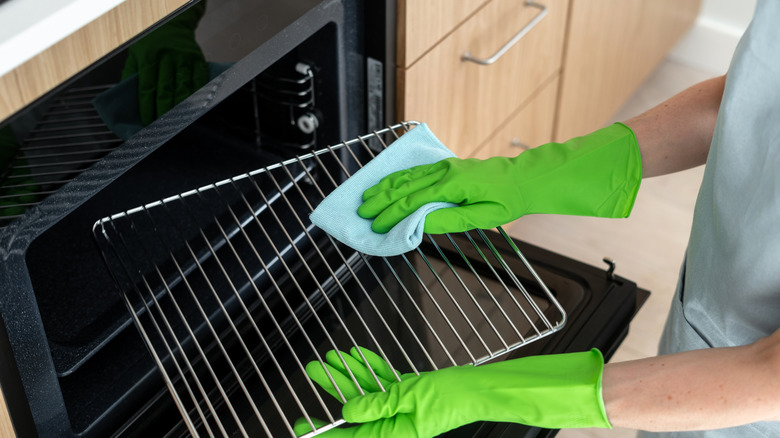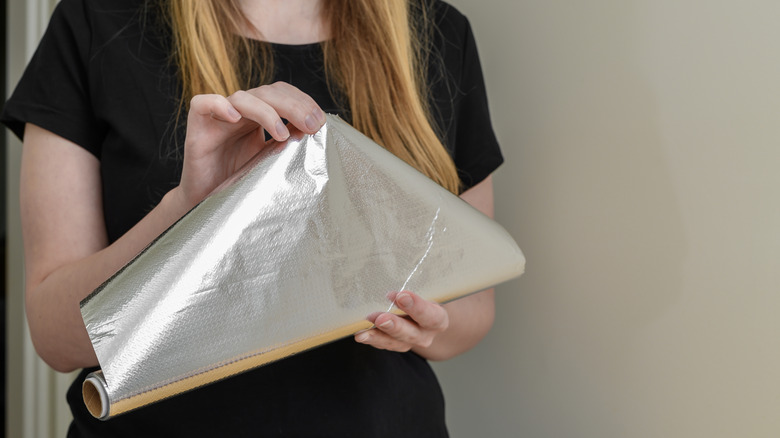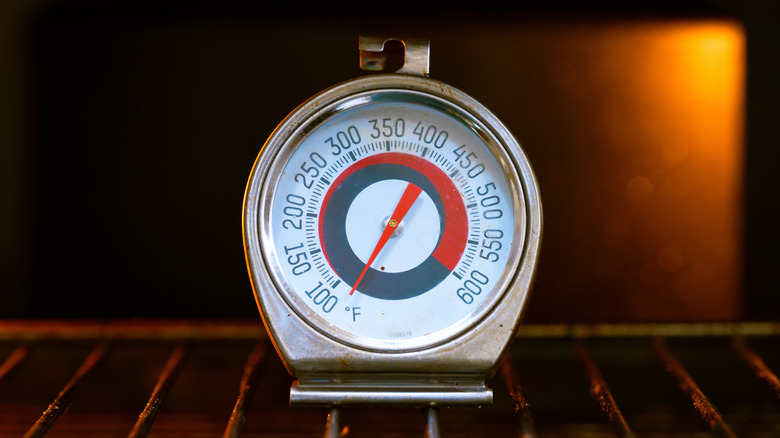13 Oven Mistakes That Are Ruining Your Food (And Oven)
While microwaves and air fryers offer speed and convenience, conventional ovens still reign supreme when it comes to the preparation of certain dishes. From whipping up crusty bread to cooking pork roast with maximum crackling crunch, the consistent, even heat of conventional ovens is hard to beat. In addition, their range of settings can give home chefs greater control over baking, broiling, and roasting.
But just like any other kitchen appliance, ovens are only as effective as the person behind the controls. After all, even the most high-tech oven can ruin a dish if used incorrectly. Luckily, mastering a few essential oven basics can stop you from unwittingly serving up a disappointing dinner. All it takes is a little know-how and adjustments to your cooking routine.
Whether you are a seasoned home chef or a complete newbie, knowing the most common oven pitfalls can improve your cooking game and extend the lifespan of your appliance. With this in mind, check out our roundup of everyday blunders that could be ruining both your dishes and oven.
Failing to preheat the oven
There is a reason why so many recipes open with a reminder to preheat the oven. Popping your food into a cold oven can lead to uneven cooking and subpar final results. More precisely, not preheating the oven can result in undercooking or overcooking because the stated cooking time in the recipe assumes that the oven is at the target temperature from the start. Failing to preheat the oven can also affect food safety, as placing meat and poultry in a cold oven means that it will spend more time in the so-called danger zone between 40 and 140 degrees Fahrenheit, where bacteria multiply at a rapid rate.
If you aren't sure how much time to allocate to preheating, the average oven reaches 350 degrees Fahrenheit in 12 to 15 minutes. For temperatures above this, every 100 degrees Fahrenheit over 350 typically adds 5 minutes of preheating time. To reduce this time, be sure to remove any unnecessary racks from the appliance, and don't open the oven door until it reaches the desired temperature. As a rule of thumb, electric ovens will take a little longer to preheat than their gas counterparts.
Different oven types have different ways of alerting you that they have reached the desired temperature. Many modern appliances come with digital temperature displays and an audible tone to let you know that it's time to place your food inside. Just be sure to use the oven as soon as it's preheated to avoid wasting electricity.
Using incorrect settings
Setting your oven to the wrong temperature or selecting the incorrect cooking mode can ruin a perfectly good feast. Making your oven too hot can lead to dried-out food, while overly cool temperatures can prevent browning or leave the inside of your food undercooked. Likewise, switching your oven to a setting designed for baking when you want to broil your food is a surefire way to derail a recipe.
While using older oven types is pretty self-explanatory — you simply set the temperature and wait — newer models often come with a range of features that can be confusing for anyone inexperienced with the model. For instance, preheat settings bring the oven to the correct temperature for your recipe. Bake functions use top and bottom heat elements and are perfect for preparing cakes and casseroles. The roast setting uses higher temperatures from both the top and bottom elements to crisp up meats and poultry. Meanwhile, broil mode uses high heat from the appliance's top element to brown, caramelize, or char dishes such as steaks. Many modern ovens may also come with a plethora of other settings, including air fry, keep warm, or frozen bake.
Forgetting to utilize the oven's convection mode
Many modern ovens come with a special convection setting that can be switched on or off depending on what is being cooked. The convection mode utilizes a fan and an exhaust to circulate air throughout the appliance, letting the food cook faster and more evenly than it would in a traditional oven.
While convection has its benefits, it's not suitable for every recipe. As such, it's best to learn when and when not to use it. For instance, it is particularly effective for roasting meats, baking trays of cookies, and crisping up foods such as pizza and vegetables. On the other hand, using convection to prepare delicate baked goods such as fluffy soufflés or velvety custards isn't recommended because it may prevent them from setting.
In addition, when using the convection setting, it's generally best to lower the temperature specified in the recipe by 25 degrees Fahrenheit and reduce the cooking time, as dishes tend to cook faster in convection ovens than in standard ovens. Many advanced oven models feature a built-in convection conversion, which can help you convert standard cooking times and temperatures for convection cooking.
Not using the appropriate bakeware
While this may come as a surprise to some, not all baking pans are the same. Different materials, shapes, and colors can influence heat distribution and the final texture and browning of your baked goods. This is why you should always select the appropriate bakeware for each specific dish. The pan shape can play a vital role in how baked goods rise and cook.
For example, straight-sided pans are ideal for making flat-topped cakes with clean edges, such as layer cakes. Loaf pans come in different sizes, and using the correct one can help achieve a well-domed loaf of bread. Meanwhile, a pan that is too large may result in a flat loaf. Other specific pan types to consider include pizza pans, scone pans, crêpe pans, and muffin pans.
The material and color of your bakeware can also make a huge difference in results. Lightly hued aluminum pans normally lead to golden crusts and even browning, while dark aluminum pans result in darker browning and may require a slightly lower temperature than specified in the recipe. Meanwhile, stoneware is excellent for crisping, while stainless steel tends to lead to lighter — albeit somewhat uneven — browning. Finally, pans made from ovenproof glassware, ceramic, and ceramic glass typically result in crisp crusts, but you may need to lower the oven temperature by around 25 degrees Fahrenheit.
Cooking too many food items at once
If you are cooking up a feast for a large gathering, it may be tempting to fill your oven with food. However, cramming too many items inside the appliance can affect its performance and the overall quality of your dishes, leaving them overcooked or undercooked. In the worst case scenario, it can also pose a fire hazard.
The issue is that overloading the oven can obstruct airflow and prevent hot air from circulating properly, which in turn can lead to uneven cooking. Fortunately, there is an easy solution that can safeguard your food from uneven cooking and your property from damage. While it may take longer, there is a lot to be said for cooking food in batches. If necessary, you can keep each individual dish warm by covering it with foil and placing it on the stovetop until it's time to serve.
Opening the oven door too often while cooking
As tempting as it may be to take a peek at your Thanksgiving turkey or baked potatoes from time to time, opening the oven door too frequently can cause the appliance's temperature to drop. Each time you open the door, your oven has to recover the lost heat. In fact, opening the oven just once can reduce the internal temperature by as much as 25 degrees Fahrenheit. This, in turn, can lead to extended cooking times, unevenly cooked food, and a higher electricity bill.
Cracking open the oven door can be particularly detrimental when baking. The cool air can disrupt the expansion of gases in the batter, causing your baked goods to become too flat or overly dense. With recipes sensitive to moisture, opening the oven door can result in overcooked edges and undercooked centers. Finally, the vibrations created each time the oven door is opened and closed may also damage delicate baked goods.
While opening the oven door is occasionally unavoidable — such as when basting or rotating food — try to minimize how long the door stays open. To keep an eye on the progress of your food, switch on the appliance's internal light and observe it through the glass window in the door.
Not knowing when to keep the oven door open or closed when broiling
Broiling, or using direct heat from above to cook, is fast and can result in flavorful dishes. It's great for toasting cheese sandwiches or getting a crust on thin cuts of meat. Unfortunately, there is still a lot of confusion about whether you should broil with the oven door open or closed. In reality, the answer to this question is pretty straightforward, as how you broil depends on the oven type.
Gas ovens are designed to broil with the door fully closed. This is because keeping the door open could interfere with the appliance's safety mechanism and shut off the gas. Meanwhile, most electric ovens should be left slightly ajar when broiling. Letting a little heat escape during cooking stops the oven's heat cycling system from switching off before your food is ready. This, however, isn't necessarily the case with all electric ovens, as some modern models are designed for broiling with the door fully closed. If in doubt about the proper broiling method for your oven, it's best to consult your appliance's manual.
Placing food too high or too low
If you've never thought twice about which rack level you should use to cook certain foods in your oven, listen up. Food placement can make or break a dish. Most ovens feature heating elements at the top and bottom, which can affect heat distribution inside the appliance.
Rack positioning can be divided into three general levels — top, middle, and bottom. Each of these zones heats food a little differently, meaning that certain dishes will turn out better if placed on a specific level. As a rule of thumb, the middle rack is your best bet for most dishes, as it offers the most even heat distribution. Use the middle zone of your oven to prepare dishes that require uniform heating, such as casseroles, brownies, and baked potatoes.
The top and bottom oven racks are more specialized. The top rack sits closer to the top heating element, making it the preferred choice for broiling, browning, and crisping. Use this rack setting for the likes of fish or thin cuts of pork or beef. On the other hand, the bottom rack sits close to the bottom heating element and is perfect for roasting large cuts of meat and baking pies.
Neglecting to rotate pans when baking
Whether you are baking bread or making a chocolate cake, there is one additional step that can take these culinary creations to the next level. Luckily, this often-overlooked move takes very little time and effort, but it can go a long way in giving your baked goods a better, more consistent texture and more even browning.
Achieving a more even bake is as simple as taking a moment to rotate the pans during the baking process. This is due to the fact that ovens are normally hotter near the sides, as well as the top and bottom. As such, many ovens have hot spots that can be as much as 50 degrees Fahrenheit warmer than the rest of the oven. The solution? Rotate the pans 180 degrees halfway through the baking process to ensure that your dish cooks more evenly.
If you are preparing more than one dish at the same time, you may also want to swap their positions in the oven. This is as simple as moving the upper pan to the lower rack and the lower pan to the upper one. Rotating the pans this way ensures that both dishes get equal exposure to heat. This doesn't apply to convection ovens since they feature a fan that circulates air around the oven cavity.
Cooking on wax paper instead of parchment paper
While both parchment paper and wax paper can be used to wrap cold food items, they behave very differently when subjected to heat. Just as its name suggests, wax paper is coated with paraffin wax, which makes it ideal for keeping foods from sticking during storage or minimizing kitchen mess. However, if placed in the oven, the wax will melt, tainting your food and potentially even starting a fire in your appliance.
The difference between wax paper and parchment paper is that the latter is heat-resistant, making it ideal for lining baking sheets. Coated with silicone, the nonstick kitchen staple can withstand temperatures up to 425 degrees Fahrenheit. If you don't happen to have parchment paper on hand, you can easily use other alternatives. One option is to spray the pan with a nonstick spray and place the food directly on top. Alternatively, lining the pan with aluminum foil can also work in a pinch. However, while aluminum foil will protect your oven from spills, it doesn't have the nonstick properties of parchment paper, so be sure to grease it before use.
Skipping routine oven cleaning
While they may look acceptable from the outside, ovens can quickly accumulate grease, crumbs, and burned-on residue. As such, just like any other surface that comes into contact with food, ovens need to be regularly cleaned. We're not just talking about a quick wipe down with a damp cloth — we mean a proper clean. Failing to clean your oven can result in decreased cooking efficiency, as excessive grime can block its heating elements. It can also result in unpleasant odors and smoke and even affect the flavor of food.
As a rule of thumb, it's recommended that an oven is deep-cleaned every three months. However, if you use the appliance on a daily basis, it's best to give it a scrub every three weeks. It goes without saying that spot-cleaning everyday splatters between thorough cleanings can go a long way toward cutting down on the overall mess.
The good news is that modern ovens often feature a self-cleaning function. This setting utilizes ultra-high temperatures of around 800 to 900 degrees Fahrenheit to heat up the inside of the appliance and break down any food buildup. Once this cycle is complete, all you need to do is wipe away any remaining residue with a cloth. If your appliance doesn't come with an automatic cleaning function, you will need to clean it manually with a commercial oven cleaner or an alternative, such as vinegar, baking soda, or lemon juice.
Lining the bottom of the oven with aluminum foil
While lining baking pans with aluminum foil doesn't generally create any problems (if you grease it), the same can't be said for placing foil directly on the bottom of the oven. We get it — placing foil on the floor of the appliance may seem like a great way to catch any mess from the higher racks. However, this shortcut can do more harm than good.
Covering the base of the oven with aluminum foil can lead to multiple issues. First, it restricts airflow inside the oven, which can damage the lower heating element. Interfering with the flame in a gas oven and the heating element in an electric appliance can also affect the way the food cooks. This disruption can lead to uneven cooking and, ultimately, undercooked or overcooked food. If things go terribly wrong, the aluminum foil may actually affect the porcelain finish of your oven due to overheating or sticking to the oven floor, causing permanent damage to the appliance.
Forgetting to use a thermometer to check the temperature of your oven
We put a lot of faith in oven thermostats, which are often inaccurate — sometimes by as much as 25 degrees Fahrenheit. This lack of precise temperature control can lead to scorched edges and undercooked centers. It can also result in uneven baking since the temperature is especially important when it comes to delicate treats like soufflés, bread, and pastries.
The best way of making sure that your oven isn't running hot or cold is by testing it with an oven thermometer. This little device can be placed inside the oven to give you an accurate reading of its real internal temperature. It can also test the appliance for any hot spots. Once you discover temperature discrepancies, you can adjust the oven's temperature setting to match the recipe. Alternatively, you can calibrate the oven to ensure that its internal temperature actually reflects the setting on the dial or digital display. While calibrating an oven is normally pretty straightforward, the process can differ depending on the model and whether you are using a gas or electric appliance. As such, before making any adjustments, it's best to consult your oven's manual for specific instructions.
